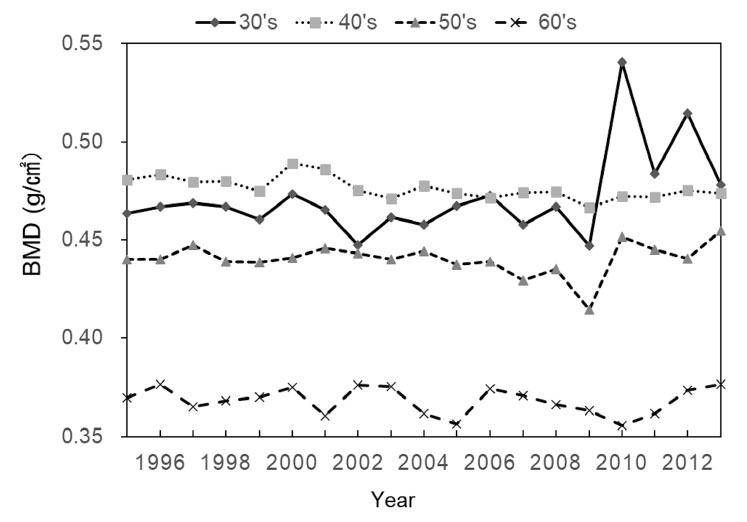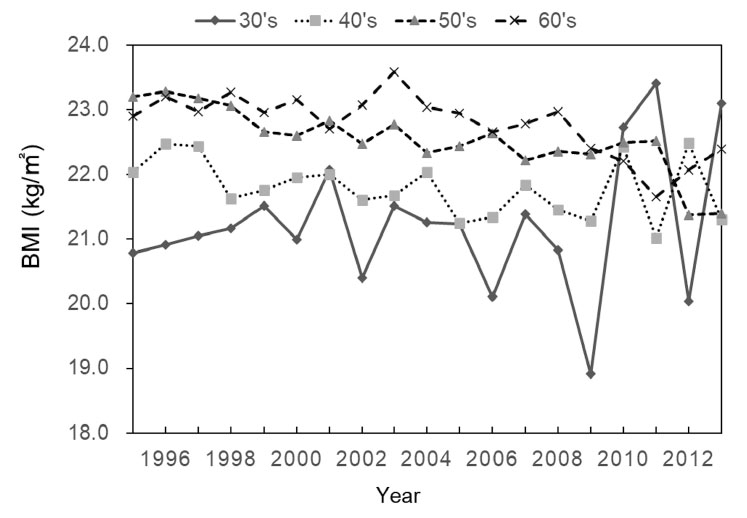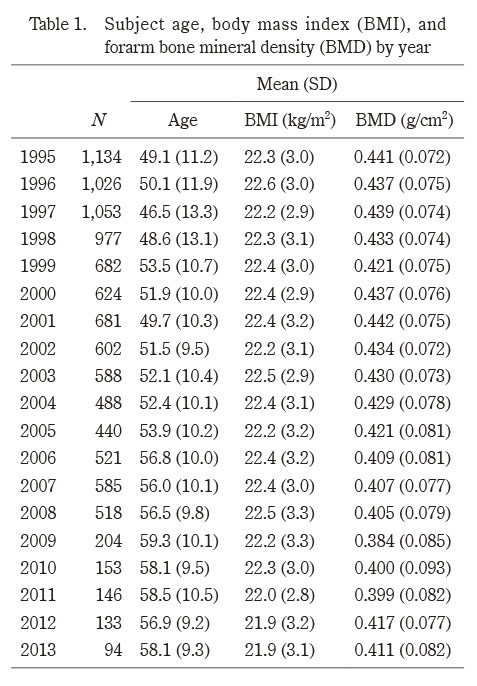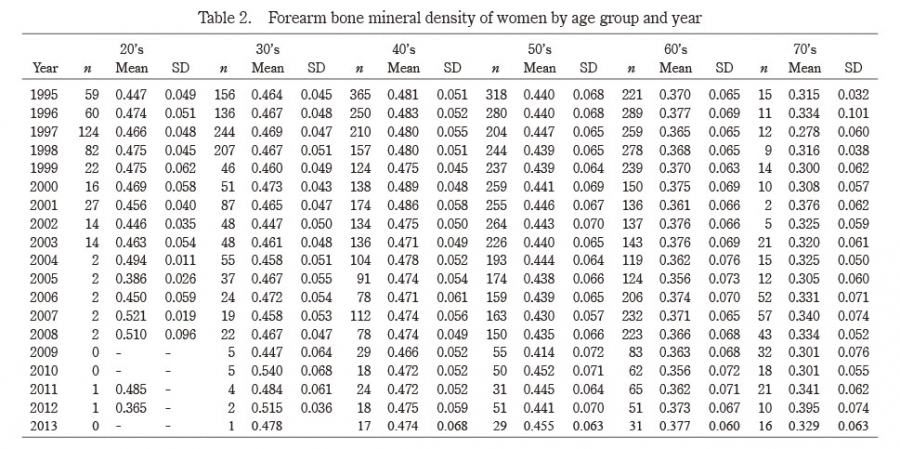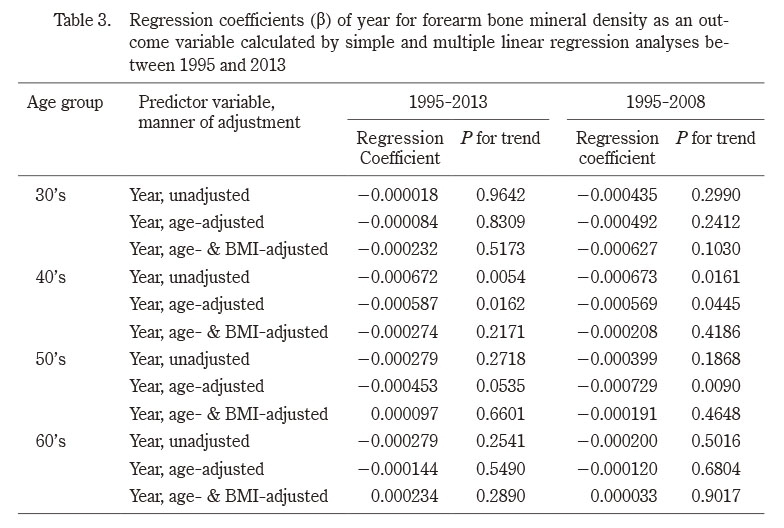1. NIH Consensus Development Panel on Osteoporosis Prevention, Diagnosis, and Therapy. Osteoporosis prevention, diagnosis, and therapy. JAMA, 28:785-795, 2001.
2. Odén A, McCloskey EV, Johansson H, Kanis JA. Assessing the impact of osteoporosis on the burden of hip fractures. Calcif Tissue Int, 92:42-49, 2013.
3. Orimo H, Yaegashi Y, Hosoi T, et al. Hip fracture incidence in Japan:Estimates of new patients in 2012 and 25-year trends. Osteoporos Int, 27:1777-1784, 2016.
4. Miyasaka D, Endo N, Endo E, et al. Incidence of hip fracture in Niigata, Japan in 2004 and 2010 and the long-term trends from 1985 to 2010. J Bone Miner Metab, 34:92-98, 2016.
5. Cooper C, Cole ZA, Holroyd CR, et al. Secular trends in the incidence of hip and other osteoporotic fractures. Osteoporos Int, 22:1277-1288, 2011.
6. Lewiecki EM, Wright NC, Curtis JR, et al. Hip fracture trends in the United States, 2002 to 2015. Osteoporos Int, 29:717-722, 2018.
7. Xu Y, Wu Q. Decreasing trend of bone mineral density in US multiethnic population:analysis of continuous NHANES 2005-2014. Osteoporos Int, 29:2437-2446, 2018.
8. Cheung E, Bow C, Loong C, et al. A secular increase in BMD in Chinese women. J Bone Miner Metab, 32:48-55, 2014.
9. Nakamura K, Hoshino Y, Watanabe A, et al. Eating problems and related weight control behaviour in adult Japanese women. Psychother Psychosom, 68:51-55, 1999.
10. Santos I, Sniehotta FF, Marques MM, Carraça EV, Teixeira PJ. Prevalence of personal weight control attempts in adults:a systematic review and meta-analysis. Obes Rev, 18:32-50, 2017.
11. Ministry of Health, Labour, and Welfare, Japan: The National Health and Nutrition Survey in Japan, 2017. Ministry of Health, Labour, and Welfare, Tokyo, 2018. (in Japanese)
12. Nakamura K, Tanaka Y, Saitou K, Nashimoto M, Yamamoto M. Age and sex differences in the bone mineral density of the distal forearm based on health check-up data of 6343 Japanese. Osteoporos Int, 11:772-777, 2000.
13. Nakamura K, Kazama JJ, Tanaka Y, et al. Microscopic hematuria is associated with low bone mineral density in aged women and men. J Bone Miner Metab, 27:251-254, 2009.
14. Kung AWC, Yates S, Wong V. Changing epidemiology in hip fracture rate in Hong Kong. Arch Osteoporos, 2:43-47, 2007.
15. Nakamura K, Saito T, Nishiwaki T, et al. Correlations between bone mineral density and demographic, lifestyle, and biochemical variables in community-dwelling Japanese women 69 years of age and over. Osteoporos Int, 17:1202-1207, 2006.
16. Nakamura K, Oyama M, Saito T, et al. Nutritional and biochemical parameters associated with 6-year change in bone mineral density in community-dwelling Japanese women aged 69 years and older:The Muramatsu Study. Nutrition, 28:357-361, 2012.
17. Ministry of Health, Labour and Welfare, Japan: The National Health and Nutrition Survey in Japan, 2013. Ministry of Health, Labour, and Welfare, Tokyo, 2015. (in Japanese)
18. Hayashi F, Takimoto H, Yoshita K, Yoshiike N. Perceived body size and desire for thinness of young Japanese women:a population-based survey. Br J Nutr, 96:1154-1162, 2006.
19. Tatsuno I, Terano T, Nakamura M, et al. Lifestyle and osteoporosis in middle-aged and elderly women:Chiba bone survey. Endocr J, 60:643-650, 2013.
20. Ministry of Health, Labour and Welfare, Japan: The National Health and Nutrition Survey in Japan, 2004. Ministry of Health, Labour, and Welfare, Tokyo, 2006. (in Japanese)
21. Iwasaki M, Yamamoto S, Otani T, et al. Generalizability of relative risk estimates from a well-defined population to a general population. Eur J Epidemiol, 21:253-262, 2006.
22. Nakamura K, Tsugawa N, Saito T, et al. Vitamin D status, bone mass, and bone metabolism in home-dwelling postmenopausal Japanese women: Yokogoshi Study. Bone, 42:271-277, 2008.
23. Nakamura K, Ueno K, Nishiwaki T, et al. Nutrition, mild hyperparathyroidism, and bone mineral density in young Japanese women. Am J Clin Nutr, 82:1127-1133, 2005.
24. Kitamura K, Nakamura K, Saito T, et al. High serum 25-hydroxyvitamin D levels do not retard postmenopausal bone loss in Japanese women:the Yokogoshi Study. Arch Osteoporos, 8:153, 2013.

